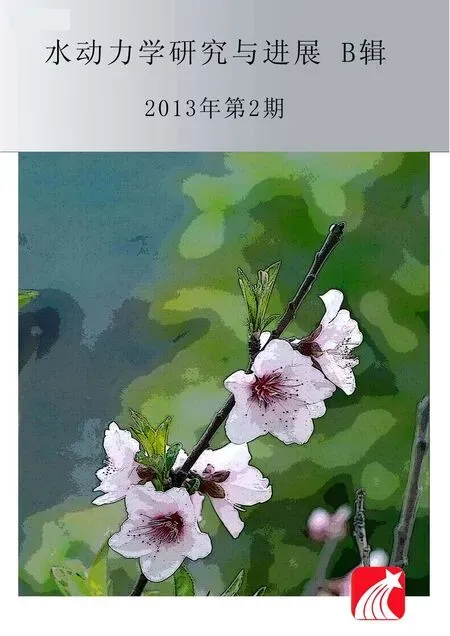Influence of emergent macrophyte (Phragmites australis) density on water turbulence and erosion of organic-rich sediment*
2013-06-01HORPPILAJukkaKAITARANTAJoniJOENSUULauraNURMINENLeena
HORPPILA Jukka, KAITARANTA Joni, JOENSUU Laura, NURMINEN Leena
Department of Environmental Sciences, University of Helsinki, Helsinki, Finland, E-mail: jukka.horppila@helsinki.fi
Influence of emergent macrophyte (Phragmites australis) density on water turbulence and erosion of organic-rich sediment*
HORPPILA Jukka, KAITARANTA Joni, JOENSUU Laura, NURMINEN Leena
Department of Environmental Sciences, University of Helsinki, Helsinki, Finland, E-mail: jukka.horppila@helsinki.fi
(Received June 11, 2012, Revised October 30, 2012)
The effects of the emergent macrophyte Phragmites australis on water turbulence, bottom shear velocity and water turbidity were experimentally studied with the stem densities 0 stems/m2-100 stems/m2and using organic-rich sediment. It is found that the maximum root-mean-square (rms) velocity and shear velocity decrease linearly with increasing stem density. By affecting the height of peak turbulence values, emergent plants can thus lower the frequency of sediment erosion events. Additionally, the slope of the rms turbulence increment decreases with increasing stem density. Thus, also the duration of strong turbulence is affected by the density of emergent macrophytes. The critical shear velocity for sediment resuspension is 0.0035 m/s-0.0055 m/s and not affected by the stem density. In the absence of macrophytes, water flow causes a 6.3-fold increment in turbidity, but with macrophytes turbidity values remain lower. The experiments suggest that even relatively low densities of Phragmites can have substantial effects on water turbulence and consequently on water quality.
emergent macrophytes, turbulence, shear velocity, resuspension, turbidity
Introduction
Aquatic macrophytes have substantial effects on sediment resuspension and erosion and thereby also on water clarity. One of the main mechanisms behind the reductive effect of macrophytes on sediment movements is their effect on hydrodynamics. Macrophytes can substantially reduce water flow velocity and turbulence compared with macrophyte-free areas[1-3]. They thus increase the wind velocity required to exceed critical shear stress at the sediment interface[2]. Due to the high variability in the architecture and distribution of plant tissue in the water column, different macrophyte species have various effects on the hydrodynamic climate in the water[1]and it is very difficult to construct models that describe the relationship between macrophyte abundance and hydrodynamics. Therefore, major efforts are required to model the interactions between hydrodynamics, sediment dynamics and macrophytes, while only a small number of studies provided numerical data to quantify the hydrodynamic effects of macrophytes[2].
Due to their complex structures, submerged species are considered to have strong effects on water movements, while species having the biomass more homogenously distributed in the water column tend to have less pronounced effects[4]. Hence, most studies on the hydrodynamic effects of aquatic macrophytes have concentrated on submerged species[1,3]. However, some studies have shown that emergent macrophytes can substantially reduce sediment resuspension[5], suggesting that they also have considerable effects on hydrodynamics. Accordingly, Wang et al.[6]found that emergent vegetation had stronger effect on water flow than submerged plant beds. Bank erosion studies have also shown that dense stands of emergent plants have a substantial attenuation effect on waves attending the shore.


1. Material and methods
1.1 Experimental setup
The study was conducted in aquaria having dimensions of 1.1 m×0.45 m×0.45 m (length×width× height) and total volume of 222 L. In each experiment, the aquarium was filled with 0.05 m layer of sediment, which was covered with a 0.30 m water layer (see Fig.1). Four different densities (0 stems/m2, 43 stems/m2, 71 stems/m2and 100 stems/m2) of Phragmites australis stems were used, following the densities commonly found in lakes and tidal wetlands[8,9]. The stems were positioned in the sediment and supported from the top edge of the aquarium. The sediment (organic content 28%) was collected with a corer from Phragmites stands of the coastal areas of the Tvärminne Archipelago of the Baltic Sea in the southwestern coast of Finland (59o50'N, 23o15'E). With each stem density, three replicate experiments were conducted. Water used in the aquaria was brackish water (4 PSU -5 PSU) sampled from the Tvärminne Bay. Water temperature during the experiments ranged between 8oC and 10oC.
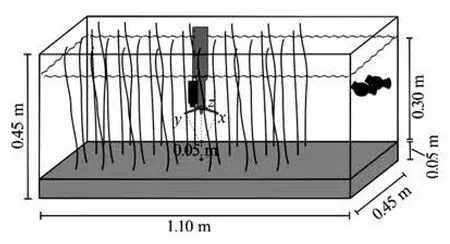
Fig.1 Experimental setup
Turbulence was generated with two computercontrolled submersible pumps (Tunze Turbelle nanostream, Tunze Aquarientechnik Gmbtt, Penzberg, 95 Germany, with maximum water discharge 1.5 L/s per pump) that were positioned on the stem-free end of the aquarium 0.05 m below the water surface (see Fig.1). The pumps were chosen to generate turbulence levels found in littoral zones[10]. Each experiment was started after a 6 h sediment settlement period with pumps set to zero discharge. Then the pump power was increased with 10% intervals, with 80 s duration at each power level. The pumps generated a main surface current towards the opposite end of the aquarium, and a returning bottom current towards the pumps. In such cases, the energy of turbulence does not increase linearly with increasing water flow velocity, because some of the energy is consumed in overcoming the internal friction when masses of water move relative to each other. It was thus expected that after some water discharge level, the turbulence starts to stabilize despite further increments in pump power. Additionally, waves (height 0 m-0.10 m) produced by the pump pulses were expected to affect the shear velocity.
1.2 Turbulence measurements and calculations
The development of turbulence within the reed stand during the experiments was measured using an Acoustic Doppler Velocimeter (ADV) (10 MHz ADVField, Sontek/YSI, San Diego, California, USA) using 25 Hz frequency (2 000 samples in 80 s). The probe was positioned at the center of the aquarium to a measuring distance of 0.05 m from the sediment surface (see Fig.1). The development of water turbidity was determined 0.15 m above the sediment surface with an optical Campbell OBS-3+ turbidity sensor connected to the ADV. The sensor measures turbidity as scattering of the light that it emits. Water turbidity measured as light scattering increases linearly with increasing concentration of suspended solids[11]. Turbidity sampling point was set higher in the water column than the turbulence sampling point to have a better view on the water quality effects of sediment erosion and to study the possible effects of macrophytes on the vertical movement of the eroded sediment in the water column[12].
From the data provided by the ADV, the rootmean-square (rms) velocities, which can be used as characteristic speeds of turbulence, were calculated
3)K-L变换,即最优正交线性变换,是一种主成分变换方法,主要是对多维数据进行降维,通过变换消除原有向量的各分量之间的相关性,从而去掉那些带有较少信息的分量以达到降低特征维数的目的,并使影像信息量的损失最小。


Fig.2 Effect of inflow Water Discharge (WD) on rms velocity among the Phragmites stand with different stem densities (± 95% confidence limits)
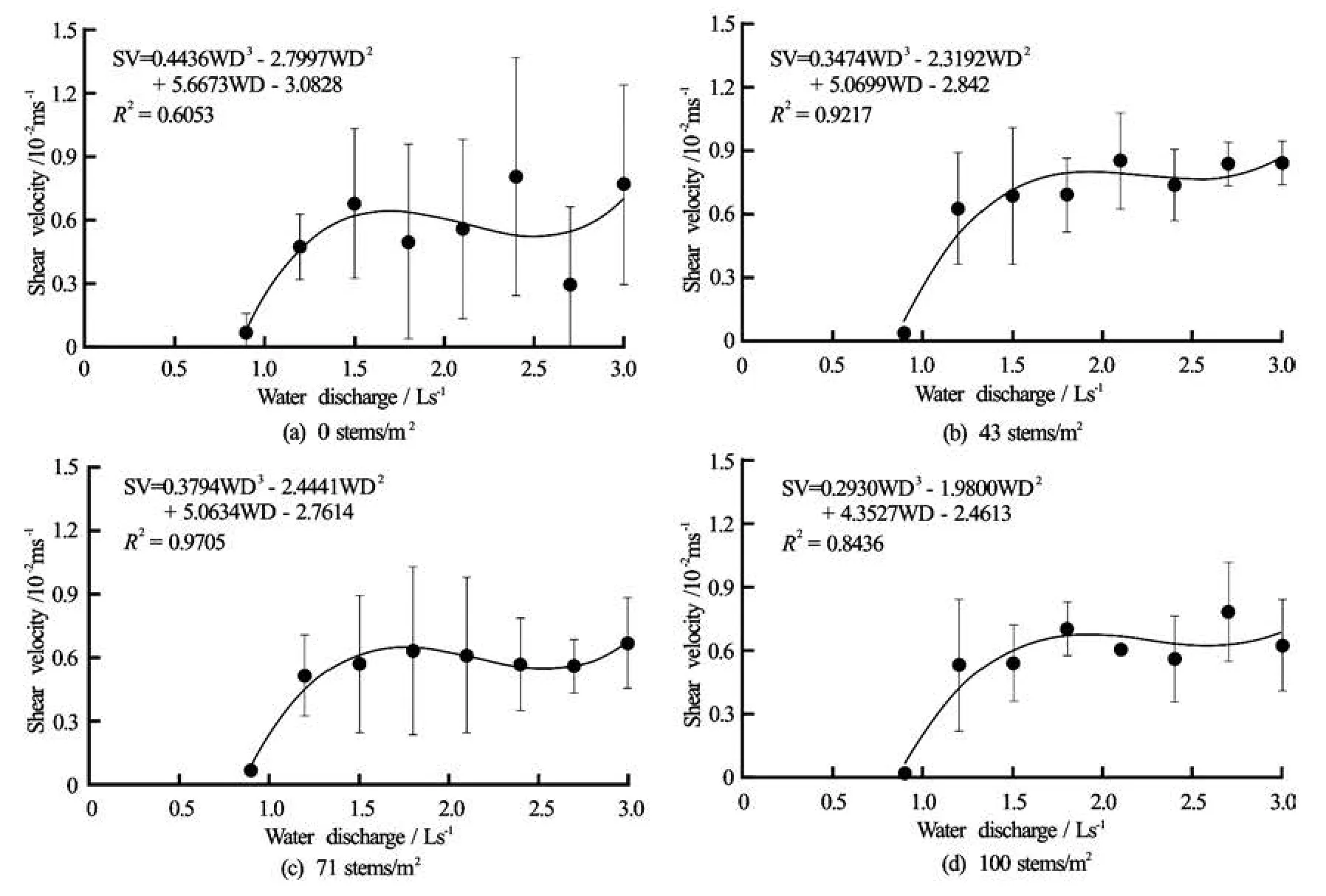
Fig.3 Effect of inflow WD on Shear Velocity (SV) among the Phragmites stand with different stem densities (±95% confidence limits)
which is the fluctuation of the flow for the Cartesian vectorxandn is the number of samples per measurement.Additionally, data were used to calculate shear velocity for the vertical velocity component, which describes the diffusion and dispersion of particles, etc. in fluid flows and the velocity profile near the boundary of a flow
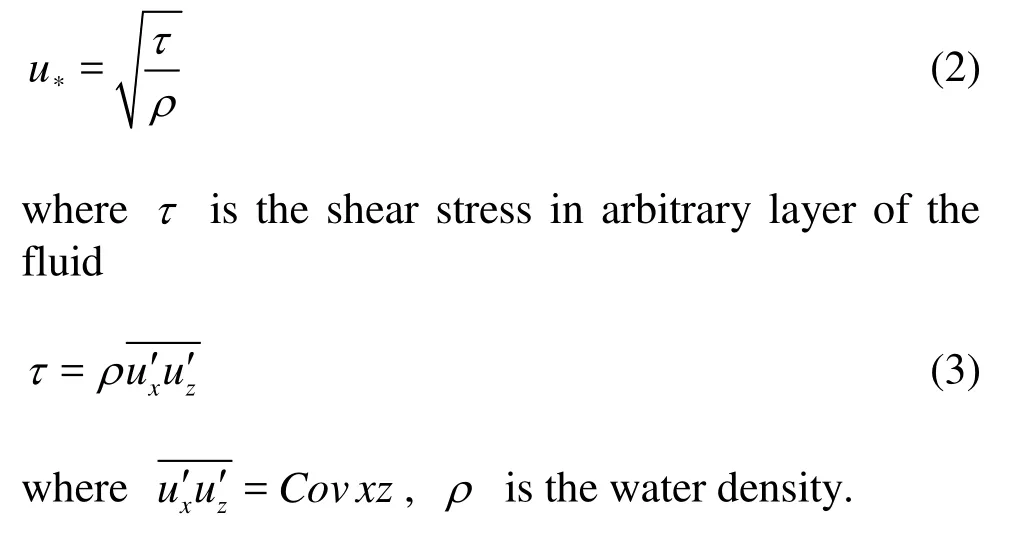
1.3 Statistical analyses
The effect of Phragmites density on turbulence was studied with nonlinear regression between water discharge, rms velocity and shear velocity. The effect of Phragmites density on the steepness of the turbulence increment during the experiments was examined by applying linear regression to analyse the effect of stem density on the slopes of the functions defining the effect of inflow water discharge on rms velocity and shear velocity. Additionally, the effect of stem density on detected maximum rms velocity and shear velocity was studied with linear regression. To improve normality, the data were ln(x+1)-transformed before the analyses. The critical shear velocity was determined as the inflection point where turbidity increased as a result of resuspension[13]. Due to variations in initial turbidity values, relative turbidity increments during the experiments were used[13]. The effect of stem density on the critical shear velocity was studied with linear regression.
2. Results
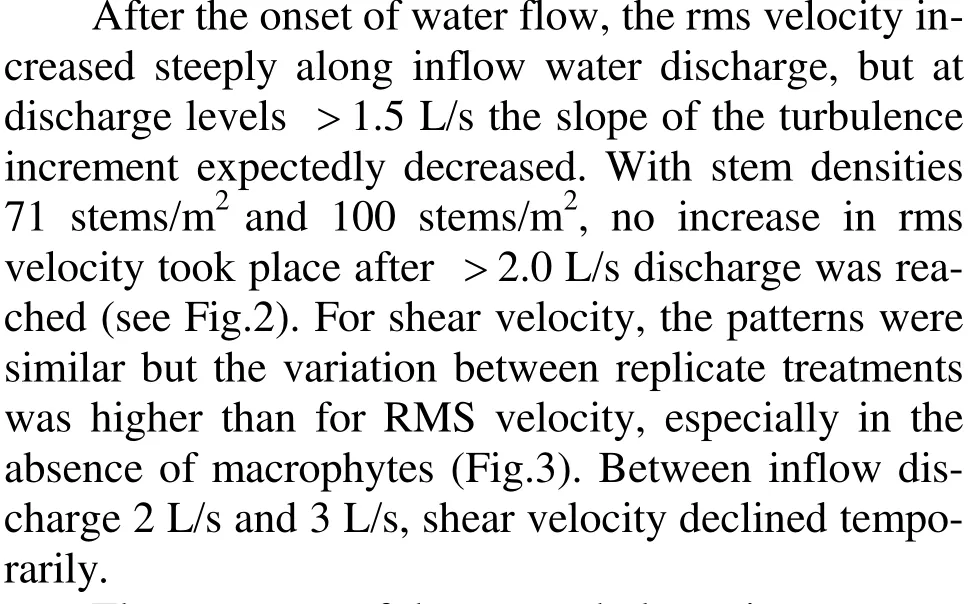
The steepness of the rms turbulence increment at low water discharge values is affected by the stem density, as shown by the decreasing slopes of the discharge-turbulence functions along increasing stem density (discharge 1.0 L/s:F1,2=23.68,P =0.0008, R2=0.9221, 1.5 L/s:F1,2=39.51,P =0.0008,R2= 0.9519) (see Table 1). At inflow discharge>2.0 L/s, the stem density has no effect on the slope (P>0.05). The slopes of shear velocity curves are independent of the stem density at all discharge values (P>0.05) (see Table 1).
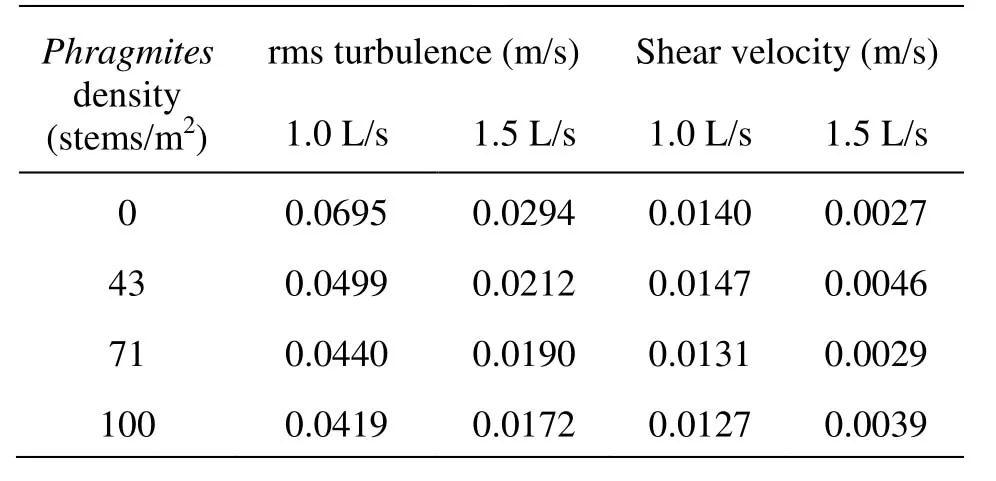
Table 1 Slopes of the functions describing the relationship between inflow water discharge to rms turbulence and shear velocity with different Phragmites densities at water discharge values 1.0 L/s and 1.5 L/s
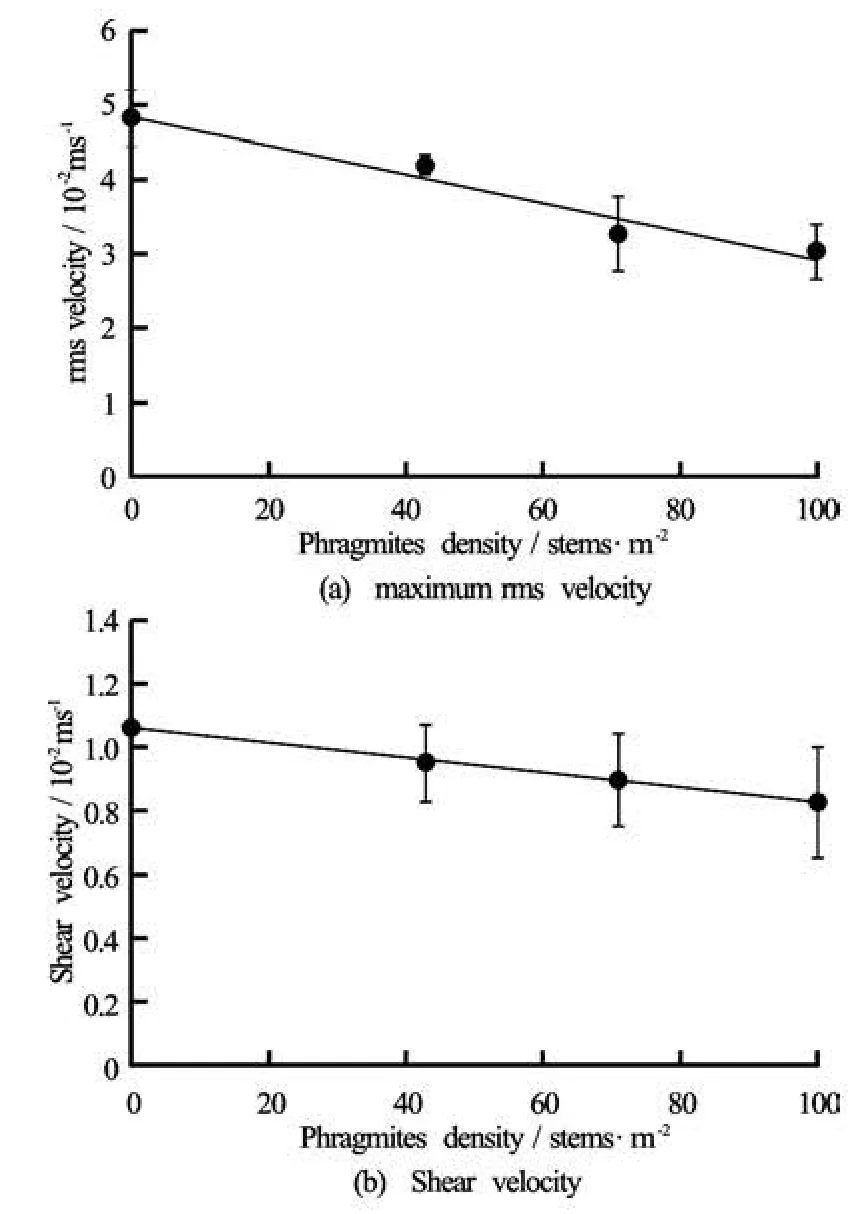
Fig.4 Effect of Phragmites density during the experiments (±95% confidence limits)
The maximum rms velocity and shear velocity values decrease along with increasing stem density (see Fig.4). The effect of stem density on the maximum values is significant for both rms velocity (F1,2=40.47,P =0.0238,R2=0.9529) and shearvelocity values (F1,2=1056.7,P =0.0009,R2= 0.9981) (see Fig.4).
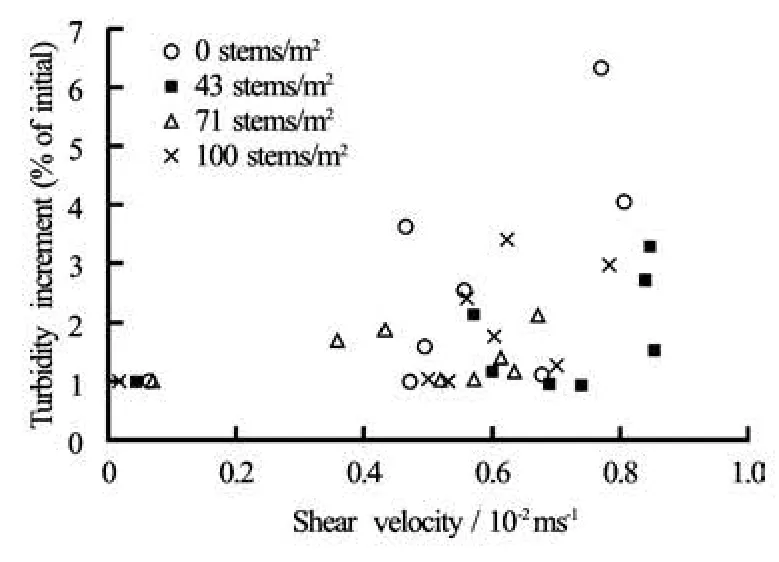
Fig.5 Effect of shear velocity on water turbidity increment with different Phragmites densities (stems/m2)
The turbidity increments were recorded when shear velocity reached 0.0035 m/s-0.0055 m/s (see Fig.5). Macrophyte density has no effect on the critical shear velocity (F1,2=0.14,P =0.7392,R2= 0.068). The highest turbidity increment (6.3-fold) was detected in the absence of Phragmites.
3. Discussion
3.1 Effects of macrophytes on water turbulence
Studies on the qualitative effect of aquatic macrophytes on horizontal water flow have given consistent results, among macrophytes the horizontal flow velocities are generally reduced[1,2]. Results of the effects of macrophytes on water turbulence have been more variable. Increased, decreased, as well as nonaffected turbulence levels in macrophyte beds have been reported[2]. The effects of even simple-structured species on water movements are complicated due to their dual effects, macrophytes tend to reduce horizontal flow velocity and at the same time they promote turbulence[7]. These opposite effects can produce a nonlinear response, where low stem densities increase turbulence due to wake production and high stem densities reduce turbulence through effects on water flow velocity. In the present study, no positive effects of emergents on turbulence were detected even with low stem densities. This is probably because, unlike flume studies, the present experiments included wave action and two-directional water current. Wave energy more readily augments turbulence in the open water than among vegetation, therefore it could be expected that the inclusion of wave action will diminish the positive effects of macrophytes on turbulence.
3.2 Effects of macrophytes on critical shear velocity
The observed critical shear velocities are well in line with previous studies. For various sediments, critical shear velocities of 0.003 m/s-0.02 m/s have been reported[14]. The sediment used in the experiments has a high organic content making it susceptible to resuspension. Also in concordance with our experiments, erosion rate of fresh deposits increases more than linear with excess shear[14]. As was expected, stem density has no significant effect on critical shear velocity at the sediment surface, but independent of the stem density sediment erosion started and water turbidity increases sharply, when shear velocity reaches 0.0035 m/s-0.0055 m/s. However, the density of Phragmites stems has a strong effect on the water discharge required to exceed the critical flow velocity level. Here it must be considered that the effects of emergent plants on sediment resuspension and erosion are not solely due to their effects on hydrodynamics, but the stabilizing effect of their roots and rhizomes on the sediment plays a role as well. Because roots were not included in the study, the experiments probably somewhat underestimated the inhibitory effect of Phragmites on sediment erosion. Turbulence among macrophytes also decreases inversely to distance from the plant bed edge facing the incoming flow. The hydrodynamic effects of plant motion, which was not included in the experiments, are negligible in rigid canopies[7]. The stem density affects the turbidity in-crement caused by given sediment resuspension rate, because macrophytes not only reduce resuspension, but also inhibit the mixing of the resuspended sediment to the water column[12].
4. Conclusions
Maximum turbulence values decreases linearly with increasing stem density of Phragmites australis in the range of 0 stems/m2-100 stems/m2. Because peak turbulence values are especially important for resuspension to occur, sediment resuspension in such stands should decrease linearly with increasing stem density. The experiments also demonstrated that the reduction of emergent macrophyte density from organic-rich littoral sediments can turn these areas from accumulation bottoms to erosion bottoms and have consequences for the water quality.
Acknowledgements
This worked was supported by the Onni Talas Foundation and by the Academy of Finland (Grant No. 131579). Noora Hellén helped with the experimental setup.
[1] VERMAAT J. E., SANTAMARIA L. and ROOS P. J. Water flow across and sediment trapping in submerged macrophyte beds of contrasting macrophyte form[J]. Archiv Für Hydrobiologie, 2000, 148(4): 549-562.
[2] MADSEN J. D., CHAMBERS P. A. and JAMES W. F. et al. The interaction between water movement, sediment dynamics and submerged macrophytes[J]. Hydrobiologia, 2001, 444(1-3): 71-84.
[3] PUJOL D., COLOMER J. and SERRA T. et al. Effect of submerged vegetation on turbulence induced by an oscillating grid[J]. Continental Shelf Research, 2010, 30(9): 1019-1029.
[4] SCHULZ M., KOZERSKI H.-P. and PLUNTKE T. et al. The influence of macrophytes on sedimentation and nutrient retention in the lower River Spree (Germany)[J]. Water Research, 2003, 37(3): 569-578.
[5] HORPPILA J., NURMINEN L. The effect of an emergent macrophyte (Typha angustifolia) on sediment resuspension in a shallow north temperate lake[J]. Freshwater Biology, 2001, 46(11): 1447-1455.
[6] WANG Chao, WANG Ping and WANG Pei-fang et al. Effects of aquatic vegetation on flow in the Nansi Lake and its flow velocity modelling[J]. Journal of Hydrodynamics, Ser. B, 2006, 18(6): 640-648.
[7] NEPF H., VIVONI E. R. Flow structure in depth-limited, vegetated flow[J]. Journal of Geophysical Research, 2000, 105(C12): 28547-28557
[8] MEYERSON L. A., SALTONSTALL K. and WINDHAM L. et al. A comparison of Phragmite australis in freshwater and brackish marsh environments in North America[J]. Wetlands Ecology and Management, 2000, 8(2-3): 89-103.
[9] KÄKI T., OJALA A. and KANKAALA P. Diel variation in methane emisisions from stands of Phragmites australis (Cav.) Trin ex Steud. and Typha latifolia L. in a boreal lake[J]. Aquatic Botany, 2001, 71(4): 259-271.
[10] G.-TÓTH L., PARPALA L. and BALOGH C. et al. Zooplankton community response to enhanced turbulence generated by water-level decrease in Lake Balaton. Limnology and Oceanography, 2011, 56(6): 2011-2222.
[11] HOLMROOS H., NIEMISTÖ J. and WECKSTRÖM K. et al. Field experiment on the seasonal variation of resuspension-mediated aerobic release of phosphorus[J]. Boreal Environment Research, 2009, 14: 937-946.
[12] HORPPILA J., NURMINEN L. Effects of different macrophyte growth forms on sediment and P resuspension in a shallow lake[J]. Hydrobiologia, 2005, 454(1): 167-175.
[13] JAMES W. F., BARKO J. W. and BUTLER M. G. Shear stress and sediment resuspension in relation to submersed macrophyte biomass[J]. Hydrobiologia, 2004, 515(1-3): 181-191.
[14] KLEEBERG A., KÖHLER J. and SUKHODOLOVA T. et al. Effects of aquatic macrophytes on organic matter deposition, resuspension and phosphorus entrainment in a lowland river[J]. Freshwater Biology, 2010, 55(2): 326-345.
10.1016/S1001-6058(13)60365-0
* Biography: HORPPILA Jukka (1962-), Male, Ph. D., Professor
猜你喜欢
杂志排行
水动力学研究与进展 B辑的其它文章
- An experimental study on runup of two solitary waves on plane beaches*
- Electro-osmotic flow of a second-grade fluid in a porous microchannel subject to an AC electric field*
- Parametric instability of a liquid metal sessile drop under the action of low-frequency alternating magnetic fields*
- Influence of flow field on stability of throttled surge tanks with standpipe*
- Hydrodynamic performance of a vertical-axis tidal-current turbine with different preset angles of attack*
- Observation of the induced pressure in a hybrid micro/nano-channel*
